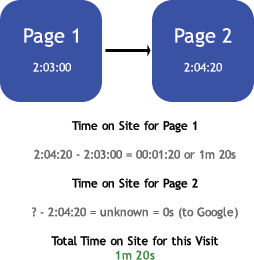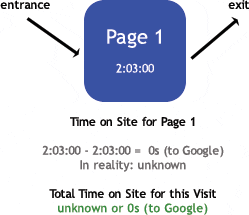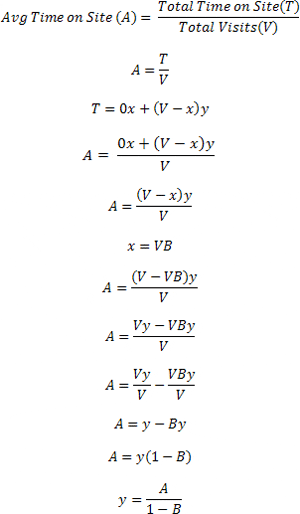Ah, Average Time on Page and Average Time on Site – what strange metrics. They sound so simple, but as I hope to point out in this article, both must be treated with caution. Due to the way Time on Page/Site are measured, there is a certain amount of error that goes along with them. Fortunately, there’s a way to measure this error.
In the interest of getting to the point, I’ve provided two versions of this article. The first version is the short version. No proof, just the final answer. For those of you who demand proof (as I hope you do) – I’ve also provided the long version, with diagrams and Algebra and everything. Feel free to choose the version that suits you!
SHORT VERSION
Time on Page is more credible when a page has a lower Exit Rate, and Time on Site is more reliable when a source/medium/etc. has a lower Bounce Rate.
Confidence in Time on Page
Applies only to a page or group of pages
Example: The Exit % for my home page, /index.htm, is 30%, so confidence in Time on Page is 70%.
In other words, the Time on Page only applies to 70% of my home page views, and I know absolutely nothing about the other 30% – other than they all resulted in exits.
True Time on Site
Applies to any source, medium, campaign, keyword, ad, or user defined value
Example: My AdWords traffic has a Bounce Rate of 40%, and Google Analytics has my Avg. Time on Site for AdWords as 00:01:00 (1 minute)
So:
True Time on Site is 1/(1-.40) = 1/.6 = 1.67 = 1m 40s
My True Time on Site is 1m 40s, which represents 60% of my AdWords traffic.
Also, the Time on Site is unknown for 40% of my AdWords traffic.
END OF SHORT VERSION
I don’t expect anyone to take my word for any of this, and I love to talk about these kinds of things, so I’ve provided a longer version for those that might be interested in how I came to the above conclusions.
LONG VERSION
First things first – how is Time on Page measured in Google Analytics? I’ve created the following diagram to try and explain it:

Here’s what happens in the above two-page visit. The visitor comes to Page 1 and the timestamp is registered. If the visitor then goes to Page 2, another timestamp is registered. Google can then take the difference of those two timestamps and come up with a Time on Page for Page 1.
Looking at Page 2 however, there is no timestamp for the next page, so Google Analytics is not able to calculate a time on page for Page 2.
What does this mean?
It means that if the page is an exit page for a specific visit, Time on Page is not calculated.
This makes sense, but it also means that you only have time data for (1 – Exit Rate) percent of pageviews.
So if the Exit Rate for a page is 40%, then the Time on Page metric only applies to 60% of pageviews.
Conclusion: The lower a page’s Exit Rate, the more confident you can be in the Time on Page metric for that page.
How about Time on Site?
Time on Site is a little different, because instead of pageviews, it relies on visits. Since every single visit has an exit, you can’t use Exit Rate when looking at your confidence level.
Time on Site is calculated by taking the timestamp of the final page of the visit (the Exit Page), and subtracting the timestamp of the first page.
So if I enter the site at 2pm and I start to view my last page at 2:10pm, Google Analytics will record my Time on Site as 10 minutes. Keep in mind that this time ignores the amount of time spent on the last page of my visit.
Which brings us to point #1:
Time on Site does not include time spent on the final page of a visit.
There is one special case which causes an additional problem. For a single-page visit (a bounce), the entrance page is also the exit page. This means that the Time on Site will be zero:

Which brings us to point #2:
Time on Site factors in a 0 for every bounce, even though Time on Site for bounces is unknown!
This means that confidence in Avg. Time on Site is related to Bounce Rate.
Not being the kind of person who is content with that conclusion, I brought some Algebra into the discussion. For those of you who hate Algebra, the conclusion is that
True Time on Site = Average Time on Site / (1 – Bounce Rate)
*Note that Bounce Rate here refers to the decimal value (i.e 40% = 0.40)
So for AdWords, if my Avg. Time on Site is 1m, and the Bounce Rate from Google Analytics is 40%, then
True Time on Site = 1/(1-0.4) = 1/0.6 = 1.67m = 1m 40s
Therefore, for AdWords Traffic, I know that non-bouncers spent an average of 1m 40s on the site. For the 40% of the traffic that bounced, I have absolutely no idea.
As my bounce rate gets lower, the Avg. Time on Site becomes much closer to the actual time spent on the site by all of my visitors.
Here’s my entire thought process using Algebra:
In the below set of equations,
- x is the number of visits that were bounces
- y is the amount of time spent on the site by people who didn’t bounce
- B is the Bounce Rate
- V is the number of Visits
- A is the Avg. Time on Site found in Google Analytics
- T is the Total Time on Site for all Visits




